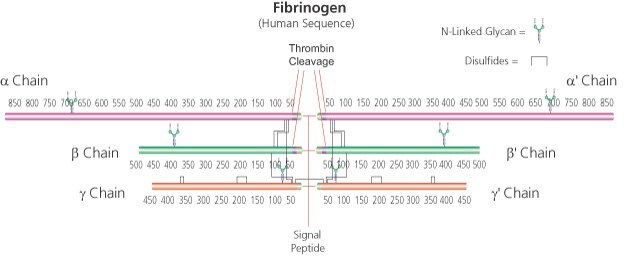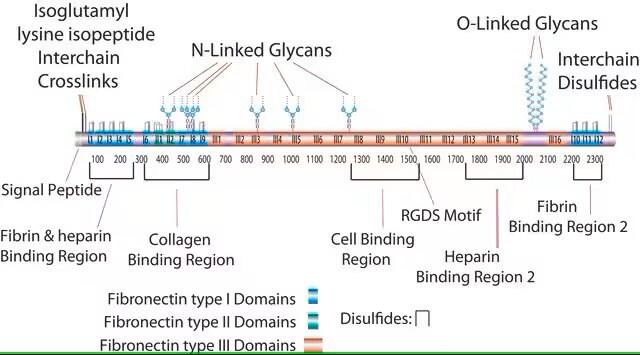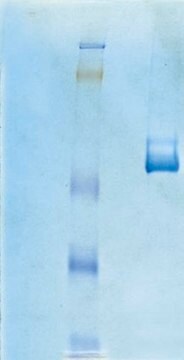FC010
Fibronectine plasmatique humaine, protéine purifiée
This Human plasma fibronectin is a purified protein, used as an attachment factor suitable for cell propagation in vitro.
About This Item
Produits recommandés
Source biologique
human
Niveau de qualité
100
300
Stérilité
sterile; sterile-filtered
Pureté
~95% (SDS-PAGE)
Forme
liquid
Poids mol.
220 kDa
Fabricant/nom de marque
Chemicon®
Concentration
1 mg/mL
Technique(s)
cell culture | mammalian: suitable
Couverture de surface
2—10 μg/cm2
Entrée
sample type mesenchymal stem cell(s)
sample type neural stem cell(s)
sample type: human embryonic stem cell(s)
sample type epithelial cells
sample type hematopoietic stem cell(s)
sample type induced pluripotent stem cell(s)
sample type pancreatic stem cell(s)
Numéro d'accès UniProt
Spécificité de la liaison
Peptide Source: Collagen
Peptide Source: Laminin
Conditions d'expédition
wet ice
Température de stockage
2-8°C
Informations sur le gène
human ... FN1(2335)
Catégories apparentées
Description générale
Application
Actions biochimiques/physiologiques
Forme physique
Stockage et stabilité
Remarque sur l'analyse
Autres remarques
1.Determine the amount of HFN needed to coat culture vessels by multiplying the total surface area (cm2) by the desired concentration (μg/mL) of HFN. Recommended amount is 2-10 μg/cm2.
2.Wet the surface of each culture vessel to be coated with a minimum amount of sterile balanced salt solution (serum and protein free) required to cover the entire area.
3.Introduce the proper CO2 atmosphere, if required.
4.Add the calculated amount of HFN to each culture vessel.
5.Allow HFN to adsorb to the surface of the vessel for 5-20 minutes.
6.Remove residual balanced salt solution before proceeding with standard cell culture procedures
Informations légales
Clause de non-responsabilité
Code de la classe de stockage
11 - Combustible Solids
Classe de danger pour l'eau (WGK)
WGK 3
Certificats d'analyse (COA)
Recherchez un Certificats d'analyse (COA) en saisissant le numéro de lot du produit. Les numéros de lot figurent sur l'étiquette du produit après les mots "Lot" ou "Batch".
Déjà en possession de ce produit ?
Retrouvez la documentation relative aux produits que vous avez récemment achetés dans la Bibliothèque de documents.
Les clients ont également consulté
Articles
Attachment Factors for 3-Dimensional Cell Culture
The extracellular matrix (ECM) is secreted by cells and surrounds them in tissues.
Development of a novel serum-free and xeno-free human mesenchymal stem cell (MSC) osteocyte differentiation media.
Extracellular matrix proteins such as laminin, collagen, and fibronectin can be used as cell attachment substrates in cell culture.
Protocoles
Dilute fibronectin to the desired concentration. Optimum conditions for attachment are dependent on cell type and application. The typical coating concentration is 1 – 5 ug/cm2.Fibronectin coating protocol, products, and FAQs.
This page covers the indirect co-culture of embryonic stem cells with embryonic fibroblasts.
Information about mesenchyme, specifically mesenchymal stem cell procotols. Step-by-step cell culture protocols for mesenchymal stem cell (MSC) isolation, expansion and differentiation.
Contenu apparenté
This page covers the ECM coating protocols developed for four types of ECMs on Millicell®-CM inserts, Collagen Type 1, Fibronectin, Laminin, and Matrigel.
Notre équipe de scientifiques dispose d'une expérience dans tous les secteurs de la recherche, notamment en sciences de la vie, science des matériaux, synthèse chimique, chromatographie, analyse et dans de nombreux autres domaines..
Contacter notre Service technique





